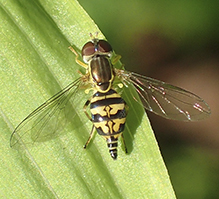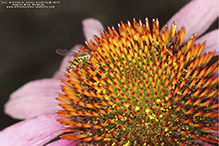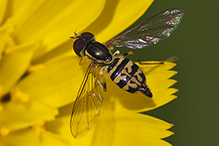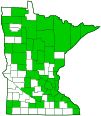eastern calligrapher
(Toxomerus geminatus)
Conservation • Description • Habitat • Ecology • Distribution • Taxonomy
|
|
||||||||||||||
Description |
Sryphid flies are considered beneficial because they prey on insects that attack ornamental plants and crops. Eastern calligrapher is a common small syrphid fly. It occurs in North America east of the Great Plains and in adjacent Canadian provinces. It is one of the most abundant species of hover flies (family Syrphidae), also called flower flies. It is very common in Minnesota. Adults are ¼″ to 5 ⁄16″ (6.1 to 7.6 mm) in length. The coloration is an example of Batesian mimicry, resembling the warning coloration of stinging bees and wasps. The back of the head is white. There are two large compound eyes, one on each side of the head, and three small simple eyes (ocelli) in a triangle at the top of the head between the compound eyes. The compound eyes are reddish-brown and are narrowly indented on the rear margin in the shape of a broad triangle. On the male the compound eyes meet near the top of the face. On the female they do not. On the male the face is white. On the female there is a dark, broad, vertical stripe on the white face extending from between the eyes to the antennae. The antennae are short and yellow. The large, middle section of the thorax (mesonotum) is covered by a shield-shaped exoskeletal plate. The large, forward portion of the shield (scutum) is blackish-brown with faint, yellowish-brown, longitudinal stripes. It is hairless. On most Toxomerus species there is a very small yellow spot, called the supracoxal marking, on the side of the thorax just above the first segment (coxa) of the front leg. Supracoxal means “above the coxa”. This mark is present on all Toxomerus species except T. germinatus and T. boscii. Thin-lined calligrapher (T. boscii) does not occur in Minnesota. The smaller, rearward part of the shield (scutellum) is similarly colored but has yellow hairs. The shield has a well-defined yellow margin. The abdomen is yellow with black stripes. The rear half of the third abdominal segment is mostly black. The tip of the abdomen is rounded in males, pointed in females. On males, the third segment (femur) of the hind leg is bowed (arcuate). The wings are clear. |
Size |
Total length: ¼″ to 5 ⁄16″ (6.1 to 7.6 mm) |
Similar Species |
Habitat |
A wide variety of habits, including forests, fields, savannas, marshes, bogs, and fens |
Ecology |
Season |
Late April to late October |
Behavior |
Adults can often be seen hovering over plants, a favorite activity that gives this family one of it’s common names. Syrphid flies do not bite or sting. |
Life Cycle |
|
Larva Food |
Aphids and mites |
Adult Food |
Flower pollen and nectar |
Distribution |
||
|
Sources Telford, Horace S.. (1939). The Syrphidae of Minnesota. University of Minnesota. Minnesota Agricultural Experiment Station. Biodiversity occurrence data published by: Minnesota Biodiversity Atlas (accessed through the Minnesota Biodiversity Atlas Portal, bellatlas.umn.edu, 6/20/2025). |
|
| 6/20/2025 | ||
Occurrence |
||
Very common |
||
Taxonomy |
|
Order |
|
Suborder |
Brachycera |
Infraorder |
Cyclorrhapha |
Zoosection |
Aschiza |
Family |
Syrphidae (Hover Flies) |
Subfamily |
|
Tribe |
Syrphini |
Genus |
Toxomerus (calligrapher flies) |
Tribe |
|
Subordinate Taxa |
|
|
|
Synonyms |
|
Eumerus privernus Scaeva geminatus Syrphus interrogans Toxomerus geminata Toxomerus notatus |
|
Common Names |
|
eastern calligrapher |
|
Glossary
Dorsal
Referring to the upper surface or back of an insect.
Femur
On insects and arachnids, the third, largest, most robust segment of the leg, coming immediately before the tibia. On humans, the thigh bone.
Mesonotum
The principal exoskeletal plate on the upper (dorsal) part of the middle segment of the thorax of an insect.
Scutellum
The exoskelletal plate covering the rearward (posterior) part of the middle segment of the thorax in some insects.
Scutum
The exoskelletal plate covering the forward (anterior) part of the middle segment of the thorax in some insects.
Visitor Photos |
||
Share your photo of this insect. |
||
This button not working for you? |
||
Luciearl |
||
 |
 |
|
On golden alexander |
||
|
||
 |
||
Babette Kis |
 |
Alfredo Colon |
 |
MinnesotaSeasons.com Photos |
||
 |

Visitor Videos |
||
Share your video of this insect. |
||
This button not working for you? |
||
|
Other Videos |
||
Flower Fly (Syrphidae:Toxomerus geminatus) Wasp Mimic |
About
Uploaded on Jun 12, 2011 Photographed at the Turtle River State Park, North Dakota (08 June 2011). |
Syrphid Fly (Syrphidae: Toxomerus geminatus) on Leaf |
About
Uploaded on Jul 8, 2010 Photographed at the Rydell NWR, Minnesota (07 July 2010). |

Visitor Sightings |
||
Report a sighting of this insect. |
||
This button not working for you? |
||
Luciearl |
Location: Lake Shore, MN On golden alexander |
 |
| Luciearl 9/20/2024 |
Location: Lake Shore, MN |
 |
| Babette Kis 5/24/2021 |
Location: Barnes Prairie, Racine Co., WI |
 |
| Alfredo Colon 8/2/2019 |
Location: Woodbury, MN |
 |
MinnesotaSeasons.com Sightings |
||

Created: 3/18/2019 Last Updated: © MinnesotaSeasons.com. All rights reserved. |



